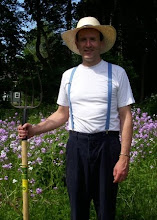This has been the best year yet for seed starting. I feel like I have a system that works well and requires minimal effort. Here is the basic outline:
Starting with five trays:
* one tray of micro-blocks (3/4" - 224 to a tray) with bottom heat set to 72 deg F, including tomatoes, peppers, parsely, cilantro, kale, chard, choi, basil, celery, and marigolds. These are transplanted to regular or mini-blocks once they are at least 1/2" tall.
* one tray of lettuce in mini-blocks. May be planted more densely than one plant per block since they can be separated and replanted when transferring to the garden. These can be transplanted to the garden when they are 3 or 4 inches tall and have more than one set of true leaves.
* three trays of peas planted in mini-blocks (1.5" - 48 to a tray). The peas are first soaked in a wide-mouth half-pint mason jar overnight and then rinsed a couple times a day until the radicle (first root) begins to separate from the seed. These can be planted outside as soon as the seedlings are a couple of inches tall.
 |
| Peas with radicles ready to plant |
 |
| Peas planted in soil blocks |
The trays are setup under 4' fluorescent lights that are suspended about 3" above the blocks. The lights are set to be on 16 hours each day. There is also a fan standing at the same height as the seedlings. It is set to come on at a medium setting for about 45 minutes, three times a day. This provides stimulation that the plants need to grow strong so that they will be able to stand up to wind and rain when they are planted out.
Here is the seed starting setup --
 |
| Bottom heat on top left tray. Thermostatic control on far left. |
 |
| Lights should be only inches above the seedlings. |





























